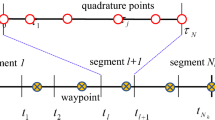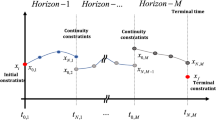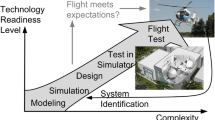Abstract
An inverse-simulation problem is reformulated to exactly satisfy the kinematic constraints imposed by the prescribed trajectory. Thereby, the problem can be transformed into an index 1 differential–algebraic equation that is much more easily solvable than the higher index system of the conventional formulation. Various numerical methods which have been successfully used in the pseudo-spectral inverse-simulation techniques are adopted with some modifications to efficiently solve the resultant system. The paper proposes a formal algorithm to describe the detailed solution process. The algorithm is applied to the analyses of the vertical, slalom, and helical-turn maneuvers of Bo-105. The simulation results with both the conventional and present formulations are compared to show the numerical features of the present methods. Effects of the solution-control parameters, the aggressiveness level of a maneuver, the quality of the prescribed trajectory, and the fidelity level of the math model are thoroughly investigated. The results of applications show that the proposed algorithm is extremely robust in that solution convergence is less sensitive to the maneuver aggressiveness, the quality of the generated trajectory, and the solution-control parameters. Therefore, it can be concluded that the kinematically exact inverse-simulation techniques deserve to be a one of the promising inverse-simulation methods like the pseudo-spectral inverse-simulation techniques.
















Similar content being viewed by others
Abbreviations
- DAE:
-
Differential-algebraic equation
- KEIST:
-
Kinematically exact inverse-simulation technique
- MTE:
-
Mission task element
- NAE:
-
Nonlinear algebraic equation
- PIST:
-
Pseudo-spectral inverse-simulation technique
- \( {\mathbf{B}} \) :
-
Approximated Jacobian
- \( {\mathbf{C}} \) :
-
Linear velocity transformation matrix
- \( {\mathbf{f}} \) :
-
Net external force vector, function vector
- \( {\mathbf{g}} \) :
-
Function vector in nonlinear algebraic equation
- \( I_{j,k} \) :
-
Component of integration matrix
- \( {\mathbf{J}} \) :
-
Moment of inertia matrix, Jacobian
- \( K \) :
-
Number of waypoints along a trajectory
- \( m \) :
-
Aircraft mass
- \( {\mathbf{m}} \) :
-
Net external moment vector
- \( N \) :
-
Number of quadrature points
- \( N_{\text{h}} \) :
-
Number of time horizons
- \( {\mathbf{p}} \) :
-
Prescribed trajectory parameter vector
- \( {\mathbf{r}} \) :
-
Position vector, \( \left( {x,y,z} \right)^{T} \)
- \( {\mathbf{r}}^{p} ,\psi^{p} \) :
-
Position and heading of prescribed trajectory
- \( {\mathbf{x}} \) :
-
System state vector
- \( {\mathbf{y}} \) :
-
Unknown states and controls
- \( {\mathbf{T}} \) :
-
Angular rate transformation matrix
- \( {\mathbf{u}} \) :
-
Control input vector
- \( {\mathbf{v}} \) :
-
Linear velocity vector, \( \left( {u,v,w} \right)^{T} \)
- \( \alpha \) :
-
Under-relaxation factor for NAE solver
- \( \varepsilon \) :
-
Numerical tolerance
- \( {\varvec{\upomega}} \) :
-
Angular velocity vector, \( \left( {p,q,r} \right)^{T} \)
- \( {\boldsymbol{\varphi}} \) :
-
Angular position vector \( \left( {\phi ,\theta ,\psi } \right)^{T} \)
References
Murray-Smith DJ (2000) The inverse simulation approach: a focused review of methods and applications. Math Comput Simul 53(4–6):239–247. https://doi.org/10.1016/S0378-4754(00)00210-X
Thomson DG, Bradley R (2006) Inverse simulation as a tool for flight dynamics research—principles and applications. Prog Aerosp Sci 42:174–210. https://doi.org/10.1016/j.paerosci.2006.07.002
Lu L, Murray-Smith DJ, Thomson DG (2008) Issues of numerical accuracy and stability in inverse simulation. Simul Model Pract Theory 16:1350–1364. https://doi.org/10.1016/j.simpat.2008.07.003
Brenan KE, Campbell SL, Petzold LR (1996) Numerical solution of initial-value problems in differential-algebraic equations. In: Society for industrial and applied mathematics. Classics in Applied Mathematics, Philadelphia, pp 157–170. ISBN 978-0-89871-353-4, https://doi.org/10.1137/1.9781611971224
Ascher UM, Petzold LR (1998) Computer methods for ordinary differential equations and differential-algebraic equations. In: Society for industrial and applied mathematics, Philadelphia, pp 231–253. ISBN: 978-0-89871-412-8
Kim C-J, Lee DH, Hur SW (2019) Efficient and robust inverse simulation techniques using pseudo-spectral integrator with applications to rotorcraft aggressive maneuver analyses. Int J Aeron Space Sci. https://doi.org/10.1007/s42405-019-00160-x
Anon (2000) Handling qualities requirements for military rotorcraft. Aeronautical design standard ADS-33E-PRF, United States army aviation & troop command, March 2000
Vepa R (2014) Flight dynamics, simulation, and control for rigid and flexible aircraft, 1st edn. CRC Press, pp 111–122. ISBN: 978-1466573352
Kim C-J, Lee DH, Hur SW, Sung S (2016) Fast and accurate analyses of spacecraft dynamics using implicit time integration techniques. Int J Control Autom Syst 14(2):524–539. https://doi.org/10.1007/s12555-014-0486-5
Kim C-J, Sung S (2014) Efficient ST techniques for nonlinear optimal control analyses using a pseudospectral framework. IEEE Trans Control Syst Technol. https://doi.org/10.1109/TCST.2014.2346994
Yun Y-H, Kim C-J, Shin K-C, Yang C-D, Cho I-J (2012) Building the flight dynamic analysis program, HETLAS, for the development of helicopter FBW system. In: American Helicopter Society International, 1st Asian Australian rotorcraft forum and exhibition, Busan, Korea, 12–15 Feb 2012
Kim C-J, Shin KC, Yang CD, Cho IJ (2012) Interface features of flight dynamic analysis program, HETLAS, for the development of helicopter FBW system. In: 1st Asian Australian rotorcraft forum and exhibition
Acknowledgements
This paper was supported by Konkuk University in 2017.
Author information
Authors and Affiliations
Corresponding author
Additional information
Publisher's Note
Springer Nature remains neutral with regard to jurisdictional claims in published maps and institutional affiliations.
Rights and permissions
About this article
Cite this article
Kim, CJ., Lee, S.H. & Hur, S.W. Kinematically Exact Inverse-Simulation Techniques with Applications to Rotorcraft Aggressive-Maneuver Analyses. Int. J. Aeronaut. Space Sci. 21, 790–805 (2020). https://doi.org/10.1007/s42405-020-00249-8
Received:
Revised:
Accepted:
Published:
Issue Date:
DOI: https://doi.org/10.1007/s42405-020-00249-8




